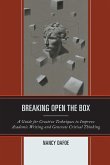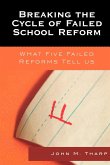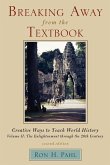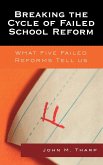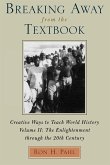Nancy Dafoe
Breaking Open the Box
A Guide for Creative Techniques to Improve Academic Writing and Generate Critical Thinking
Nancy Dafoe
Breaking Open the Box
A Guide for Creative Techniques to Improve Academic Writing and Generate Critical Thinking
- Gebundenes Buch
- Merkliste
- Auf die Merkliste
- Bewerten Bewerten
- Teilen
- Produkt teilen
- Produkterinnerung
- Produkterinnerung
We need a more creative approach to teaching writing. A methodology incorporating creativity, as modeled by students in this text, demonstrates the kind of progress we are all seeking, offering an exciting challenge for young writers and educators alike.
Andere Kunden interessierten sich auch für
![Breaking Open the Box Breaking Open the Box]() Nancy DafoeBreaking Open the Box55,99 €
Nancy DafoeBreaking Open the Box55,99 €![Breaking the Cycle of Failed School Reform Breaking the Cycle of Failed School Reform]() John M. TharpBreaking the Cycle of Failed School Reform68,99 €
John M. TharpBreaking the Cycle of Failed School Reform68,99 €![Breaking Away from the Textbook Breaking Away from the Textbook]() Ron H. PahlBreaking Away from the Textbook120,99 €
Ron H. PahlBreaking Away from the Textbook120,99 €![Breaking Away from the Textbook Breaking Away from the Textbook]() Ron H. PahlBreaking Away from the Textbook63,99 €
Ron H. PahlBreaking Away from the Textbook63,99 €![Breaking the Cycle of Failed School Reform Breaking the Cycle of Failed School Reform]() John M. TharpBreaking the Cycle of Failed School Reform140,99 €
John M. TharpBreaking the Cycle of Failed School Reform140,99 €![Breaking the Mold of Classroom Management Breaking the Mold of Classroom Management]() Andrea HonigsfeldBreaking the Mold of Classroom Management47,99 €
Andrea HonigsfeldBreaking the Mold of Classroom Management47,99 €![Breaking Away from the Textbook Breaking Away from the Textbook]() Ron H. PahlBreaking Away from the Textbook62,99 €
Ron H. PahlBreaking Away from the Textbook62,99 €-
-
-
We need a more creative approach to teaching writing. A methodology incorporating creativity, as modeled by students in this text, demonstrates the kind of progress we are all seeking, offering an exciting challenge for young writers and educators alike.
Produktdetails
- Produktdetails
- Verlag: R&L Education
- Seitenzahl: 210
- Erscheinungstermin: 21. Februar 2013
- Englisch
- Abmessung: 235mm x 157mm x 17mm
- Gewicht: 499g
- ISBN-13: 9781475802733
- ISBN-10: 1475802730
- Artikelnr.: 53216026
- Herstellerkennzeichnung
- Libri GmbH
- Europaallee 1
- 36244 Bad Hersfeld
- gpsr@libri.de
- Verlag: R&L Education
- Seitenzahl: 210
- Erscheinungstermin: 21. Februar 2013
- Englisch
- Abmessung: 235mm x 157mm x 17mm
- Gewicht: 499g
- ISBN-13: 9781475802733
- ISBN-10: 1475802730
- Artikelnr.: 53216026
- Herstellerkennzeichnung
- Libri GmbH
- Europaallee 1
- 36244 Bad Hersfeld
- gpsr@libri.de
Nancy A. Dafoe is an award-winning, published poet and fiction writer, in addition to being an educator living in Central New York. She has taught in a variety of settings and at different grade levels from 9th grade to freshmen in college.
Foreword
Acknowledgments
Introduction: Writing Well Matters
Chapter 1:Encouraging Creative Frameworks for Critical Thinking and Writing
Chapter 2: The Writer as Critical ThinkerSection 1: Playing with Language
Section 2: Taking Creative Risks to Improve Writing
Chapter 3: Recognizing the Problem
Section 1: A Familiar Scene
Section 2: Why the Essay Genre Presents Such Challenges
Section 3: The Hollow Middle
Section 4: When a Good Student Writes a Bad Essay
Section 5: When a Student Surprises with His/Her Writing
Chapter 4: Outlining Creative Applications to Academic Writing
Section 1: Where to start and how to proceed with instruction in creative
techniques and creative choices
Section 2: Applications with Metaphor
Chapter 5: Applications with Prose Poems or Poetic Prose
Chapter 6: Discourse Applications with Poetry
Chapter 7: Applications with Narrative-Story, Dialogue, and the Mini-Script
Chapter 8: Applications with Parody and Satire
Chapter 9: Applications with Musings and Journaling
Chapter 10: Applications with Unusual Vessels and Technology
Section 1: Student Applications with Unusual Vessels
Section 2: Applications with Technology
A: Texting
B: Blogging
Chapter 11: Traditional Looking Essays Incorporating Creative Techniques
Chapter 12: Changing the Landscape of Academic Writing Assignments
and the Classroom Environment
Chapter 13: Making Editing Integral
Chapter 14: Inviting the Common Core Standards into the Classroom and
Recognizing they are First Cousins to Creativity
Chapter 15: Lesson Planning Involving Creative Choice and Techniques
Section 1: Building Creative Techniques into the Writing Lesson
Section 2: Tweaking the Assessment Rubric to Encourage Creativity
Chapter 16: Setting Up Action Research
Section 1: Student Writing Surveys
Section 2: Examining Comparative Data
Section 3: A Procedural Guide-Building Creative Choice
into the Compositional Assignment
Chapter 17: Providing Students with Opportunities for Authentic Audience
Instructional Application and Dedication
Appendix A: A Guide for Parents
Appendix B: A Sampling of Young Writers' Conferences
Appendix C: Helpful, Creative Resources for Writers and Writing Instruction
Bibliography
Notes
Acknowledgments
Introduction: Writing Well Matters
Chapter 1:Encouraging Creative Frameworks for Critical Thinking and Writing
Chapter 2: The Writer as Critical ThinkerSection 1: Playing with Language
Section 2: Taking Creative Risks to Improve Writing
Chapter 3: Recognizing the Problem
Section 1: A Familiar Scene
Section 2: Why the Essay Genre Presents Such Challenges
Section 3: The Hollow Middle
Section 4: When a Good Student Writes a Bad Essay
Section 5: When a Student Surprises with His/Her Writing
Chapter 4: Outlining Creative Applications to Academic Writing
Section 1: Where to start and how to proceed with instruction in creative
techniques and creative choices
Section 2: Applications with Metaphor
Chapter 5: Applications with Prose Poems or Poetic Prose
Chapter 6: Discourse Applications with Poetry
Chapter 7: Applications with Narrative-Story, Dialogue, and the Mini-Script
Chapter 8: Applications with Parody and Satire
Chapter 9: Applications with Musings and Journaling
Chapter 10: Applications with Unusual Vessels and Technology
Section 1: Student Applications with Unusual Vessels
Section 2: Applications with Technology
A: Texting
B: Blogging
Chapter 11: Traditional Looking Essays Incorporating Creative Techniques
Chapter 12: Changing the Landscape of Academic Writing Assignments
and the Classroom Environment
Chapter 13: Making Editing Integral
Chapter 14: Inviting the Common Core Standards into the Classroom and
Recognizing they are First Cousins to Creativity
Chapter 15: Lesson Planning Involving Creative Choice and Techniques
Section 1: Building Creative Techniques into the Writing Lesson
Section 2: Tweaking the Assessment Rubric to Encourage Creativity
Chapter 16: Setting Up Action Research
Section 1: Student Writing Surveys
Section 2: Examining Comparative Data
Section 3: A Procedural Guide-Building Creative Choice
into the Compositional Assignment
Chapter 17: Providing Students with Opportunities for Authentic Audience
Instructional Application and Dedication
Appendix A: A Guide for Parents
Appendix B: A Sampling of Young Writers' Conferences
Appendix C: Helpful, Creative Resources for Writers and Writing Instruction
Bibliography
Notes
Foreword
Acknowledgments
Introduction: Writing Well Matters
Chapter 1:Encouraging Creative Frameworks for Critical Thinking and Writing
Chapter 2: The Writer as Critical ThinkerSection 1: Playing with Language
Section 2: Taking Creative Risks to Improve Writing
Chapter 3: Recognizing the Problem
Section 1: A Familiar Scene
Section 2: Why the Essay Genre Presents Such Challenges
Section 3: The Hollow Middle
Section 4: When a Good Student Writes a Bad Essay
Section 5: When a Student Surprises with His/Her Writing
Chapter 4: Outlining Creative Applications to Academic Writing
Section 1: Where to start and how to proceed with instruction in creative
techniques and creative choices
Section 2: Applications with Metaphor
Chapter 5: Applications with Prose Poems or Poetic Prose
Chapter 6: Discourse Applications with Poetry
Chapter 7: Applications with Narrative-Story, Dialogue, and the Mini-Script
Chapter 8: Applications with Parody and Satire
Chapter 9: Applications with Musings and Journaling
Chapter 10: Applications with Unusual Vessels and Technology
Section 1: Student Applications with Unusual Vessels
Section 2: Applications with Technology
A: Texting
B: Blogging
Chapter 11: Traditional Looking Essays Incorporating Creative Techniques
Chapter 12: Changing the Landscape of Academic Writing Assignments
and the Classroom Environment
Chapter 13: Making Editing Integral
Chapter 14: Inviting the Common Core Standards into the Classroom and
Recognizing they are First Cousins to Creativity
Chapter 15: Lesson Planning Involving Creative Choice and Techniques
Section 1: Building Creative Techniques into the Writing Lesson
Section 2: Tweaking the Assessment Rubric to Encourage Creativity
Chapter 16: Setting Up Action Research
Section 1: Student Writing Surveys
Section 2: Examining Comparative Data
Section 3: A Procedural Guide-Building Creative Choice
into the Compositional Assignment
Chapter 17: Providing Students with Opportunities for Authentic Audience
Instructional Application and Dedication
Appendix A: A Guide for Parents
Appendix B: A Sampling of Young Writers' Conferences
Appendix C: Helpful, Creative Resources for Writers and Writing Instruction
Bibliography
Notes
Acknowledgments
Introduction: Writing Well Matters
Chapter 1:Encouraging Creative Frameworks for Critical Thinking and Writing
Chapter 2: The Writer as Critical ThinkerSection 1: Playing with Language
Section 2: Taking Creative Risks to Improve Writing
Chapter 3: Recognizing the Problem
Section 1: A Familiar Scene
Section 2: Why the Essay Genre Presents Such Challenges
Section 3: The Hollow Middle
Section 4: When a Good Student Writes a Bad Essay
Section 5: When a Student Surprises with His/Her Writing
Chapter 4: Outlining Creative Applications to Academic Writing
Section 1: Where to start and how to proceed with instruction in creative
techniques and creative choices
Section 2: Applications with Metaphor
Chapter 5: Applications with Prose Poems or Poetic Prose
Chapter 6: Discourse Applications with Poetry
Chapter 7: Applications with Narrative-Story, Dialogue, and the Mini-Script
Chapter 8: Applications with Parody and Satire
Chapter 9: Applications with Musings and Journaling
Chapter 10: Applications with Unusual Vessels and Technology
Section 1: Student Applications with Unusual Vessels
Section 2: Applications with Technology
A: Texting
B: Blogging
Chapter 11: Traditional Looking Essays Incorporating Creative Techniques
Chapter 12: Changing the Landscape of Academic Writing Assignments
and the Classroom Environment
Chapter 13: Making Editing Integral
Chapter 14: Inviting the Common Core Standards into the Classroom and
Recognizing they are First Cousins to Creativity
Chapter 15: Lesson Planning Involving Creative Choice and Techniques
Section 1: Building Creative Techniques into the Writing Lesson
Section 2: Tweaking the Assessment Rubric to Encourage Creativity
Chapter 16: Setting Up Action Research
Section 1: Student Writing Surveys
Section 2: Examining Comparative Data
Section 3: A Procedural Guide-Building Creative Choice
into the Compositional Assignment
Chapter 17: Providing Students with Opportunities for Authentic Audience
Instructional Application and Dedication
Appendix A: A Guide for Parents
Appendix B: A Sampling of Young Writers' Conferences
Appendix C: Helpful, Creative Resources for Writers and Writing Instruction
Bibliography
Notes


